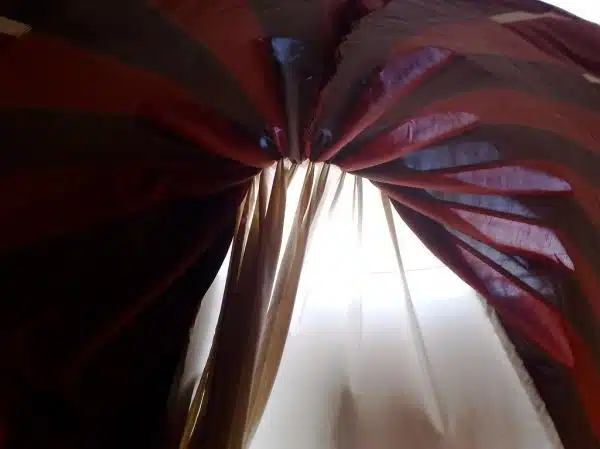Curtains are an essential part of any home decor, but they require proper care and maintenance to ensure their longevity. Whether you have invested in expensive curtains or have inherited them from your grandma, it is crucial to know how to wash and care for them properly. In this article, we will explore three different ways to clean and maintain your curtains, so they remain fresh and beautiful for years to come.
The first method involves washing your curtains with a washing machine. This process is ideal for curtains made of cotton, polyester, and linen fabrics. We will guide you through the steps involved in machine-washing your curtains without damaging their delicate fabric. The second method involves dry cleaning your curtains, which is best suited for delicate fabrics such as silk or velvet. We will provide you with tips on how to choose a reputable dry cleaner and what precautions to take before sending your curtains off for cleaning. Finally, we will explore a third method of cleaning your curtains using steamers. This method is suitable for all types of fabrics and offers a quick and easy way to remove dust and wrinkles from your curtains without having to wash them. With these three methods at your disposal, you can be sure that your curtains will always look their best while providing an elegant touch to your home decor.
Importance Of Proper Curtain Maintenance
Maintenance is essential in ensuring your curtains remain in excellent condition. The importance of proper curtain maintenance cannot be overstated, as it provides numerous benefits. Regular cleaning not only enhances the appearance of your home decor but also prolongs the lifespan of your curtains.
One benefit of maintenance is that it prevents dirt buildup and odor. Curtains collect dust, pet hair, and other debris over time. If left unattended, these particles can accumulate and cause an unpleasant smell in your room. To avoid this, you should clean your curtains regularly to keep them fresh and odor-free.
Another advantage of maintaining your curtains is that it helps protect the fabric from damage. Sunlight exposure can cause fading or discoloration on some fabrics. Frequent washing may also weaken or shrink certain materials. However, with proper care, such as vacuuming or spot cleaning, you can prevent these problems while keeping your curtains looking new.
Understanding fabric types is crucial to ensure efficient handling and cleaning of different curtain materials. By knowing what kind of fabric you have, you can identify its unique characteristics and tailor your maintenance routine accordingly. This knowledge will come in handy when choosing between different cleaning methods or deciding whether to do it yourself or seek professional help.
Understanding Fabric Types
When it comes to home decor, curtains are an essential element that adds beauty and elegance to any room. However, not all curtains are created equal. Understanding fabric durability is crucial in selecting the right type of curtain for your home. When choosing fabrics for your curtains, you should consider the amount of sunlight that enters your room. Fabrics that are exposed to direct sunlight can quickly fade and wear out over time. Therefore, it’s best to choose fabrics made from natural fibers such as cotton or silk that can withstand the sun’s harmful rays.
Identifying fabric blends is also essential when choosing the perfect curtain for your home. Blended fabrics are made up of two or more types of fibers, such as polyester and cotton or silk and linen. These combinations offer a unique blend of characteristics like softness, strength, and durability. Blended fabrics have become increasingly popular because they provide the best of both worlds in terms of texture and appearance.
In summary, understanding fabric types is crucial in selecting the right curtains for your home. Durability should be a significant factor when choosing fabrics that can withstand exposure to sunlight without fading easily. Identifying blended fabrics offers a unique combination of qualities such as softness, texture, strength, and durability. Now that we understand how important it is to choose the right fabric type let’s move on to machine-washing cotton curtains without damaging them.
Machine-Washing Cotton Curtains
Understanding Fabric Types is crucial in determining the best way to wash and care for your curtains. Cotton curtains are a popular choice due to their durability and versatility. Cotton is also easy to maintain, making it a great option for those who want low-maintenance curtains. However, cotton curtains can be prone to shrinking if not washed and dried properly.
Before washing your cotton curtains, be sure to remove any stains. You can do this by spot cleaning with a gentle detergent or using a stain remover specifically designed for cotton fabrics. Once your curtains are stain-free, you can proceed with machine-washing them. Be sure to use cold water and a gentle cycle to avoid shrinkage. When it comes to drying techniques, air-drying is recommended as high heat from tumble drying can damage the fabric.
Drying your cotton curtains may take longer than other fabrics due to its absorbent nature. To speed up the process, use a towel or two in the dryer with the curtains on low heat setting. This will help absorb moisture from the fabric and prevent shrinkage. Once dry, iron your cotton curtains on a low setting to remove any wrinkles or creases. By following these simple steps, you can ensure that your cotton curtains stay looking fresh and new for years to come.
Moving forward into machine-washing polyester curtains, it’s important to note that polyester is an easy-care fabric that resists wrinkling and shrinking. Polyester is also resistant to most stains which makes it an ideal choice for households with children or pets. In the next section, we will discuss how to properly clean and care for polyester curtains while maintaining their quality look and feel.
Machine-Washing Polyester Curtains
Practicing proper polyester curtain care is crucial to keep them looking great and lasting for a long time. One of the most effective ways to do this is through machine-washing. However, there are some machine washing tips that you should follow to avoid damaging the fabric or color fading.
Firstly, always check the care label before washing your curtains in the machine. Most polyester curtains can be washed in cold or warm water with a gentle cycle setting. Avoid using hot water as it can cause shrinkage and damage the fabric’s fibers. Also, use mild detergent and never add fabric softeners as it can leave residue on the curtains and affect their texture.
After washing your polyester curtains, it’s important to dry them correctly to prevent wrinkles or creases from forming. You can either hang them outside under shade or inside on a drying rack. Avoid direct sunlight as it can cause color fading. If you’re using a dryer, set it on low heat and remove the curtains immediately after they’re dry to avoid wrinkles.
In summary, following these simple machine washing tips will help keep your polyester curtains looking vibrant and new for years to come:
- Always check the care label before washing
- Use mild detergent and avoid fabric softeners
- Dry them correctly by hanging them outside or using a dryer on low heat
Up next, we’ll discuss how to properly care for linen curtains through machine-washing techniques that will help maintain their natural texture and appearance.
Machine-Washing Linen Curtains
When washing linen curtains, it is important to consider the type of machine settings used. Generally, a gentle cycle with cold water is recommended in order to protect the fabric. Additionally, the type of detergent used to wash linen curtains can have an effect on the lifespan of the fabric. It is advisable to use a mild detergent specifically designed for delicate fabrics.
Washing Settings
As a home decor specialist, it is essential to know the different washing methods for linen curtains. Linen curtains are delicate and require special care to maintain their quality and appearance. When machine-washing linen curtains, it is crucial to select the appropriate washing settings. The best washing practices for linen curtains are to use a gentle cycle, a mild detergent, and cold water.
Using a gentle cycle on your washing machine will protect the fabric of your linen curtains from damage. This setting reduces the agitation that can cause shrinkage or tears in the fabric. Additionally, using mild detergent will prevent any harsh chemicals from deteriorating the quality of your curtains. It is recommended to avoid bleach or fabric softeners as they may discolor or weaken the fibers of the linen material.
Lastly, using cold water when washing your linen curtains is highly recommended. Hot water can cause shrinkage and fading in color, which can drastically affect the overall look of your curtains. Cold water will preserve the curtain’s shape and color while ensuring that any dirt or stains are removed effectively.
In summary, when washing linen curtains in a machine, it is important to follow proper washing methods to ensure that they remain pristine and intact for an extended period. Remember always to use gentle cycles with mild detergents and cold water for best results!
Detergent Choices
In addition to using a gentle cycle, selecting the appropriate detergent for machine-washing linen curtains is also crucial. When it comes to detergent choices, there are a variety of options available on the market. One choice to consider is whether to use natural or synthetic detergents. Natural detergents are made from plant-based ingredients and are considered eco-friendly options. On the other hand, synthetic detergents contain chemicals that may be harmful to the environment.
Another consideration when choosing a detergent for washing linen curtains is whether to opt for hypoallergenic options. This is particularly important for those with sensitive skin or allergies. In addition, choosing between scented or unscented detergents is also a personal preference and may depend on one’s sensitivity to fragrances.
It is also essential to consider whether you have a high efficiency (HE) or regular washing machine as this will determine the type of detergent you should use. HE detergents are specially formulated for use in high-efficiency machines and produce fewer suds than regular detergents. Concentrated detergents are another option that offers more cleaning power while using less product compared to non-concentrated ones.
In conclusion, choosing the right detergent when machine-washing linen curtains can help prolong their lifespan and maintain their quality over time. Whether opting for natural or synthetic, hypoallergenic, scented or unscented, high efficiency or regular, concentrated or non-concentrated options – understanding these choices can go a long way in ensuring that your linen curtains receive proper care during washing.
Precautions To Take Before Dry Cleaning
Before taking your curtains to the dry cleaners, it is important to take certain precautions. First, remove any hooks, rings or other hardware that may be attached to the curtain. This will prevent damage to the fabric and ensure a thorough cleaning. Next, inspect the curtains for any tears or holes that may need to be repaired before cleaning. Lastly, read the care label on your curtains carefully to ensure that they are suitable for dry cleaning.
If you prefer not to use dry cleaning services, there are alternative methods of cleaning your curtains at home. One option is hand washing with mild detergent and lukewarm water in a large tub or sink. Be sure to rinse thoroughly and hang them up outside to air-dry in the shade. Another option is machine washing on a delicate cycle with cold water and a gentle detergent. Use a mesh laundry bag if possible and avoid using fabric softeners or bleach.
It’s important to note that not all fabrics are suitable for dry cleaning alternatives such as hand washing or machine washing. Some fabrics may shrink or lose their shape when exposed to water or harsh detergents. If you’re unsure about how to clean your curtains safely, it’s best to seek advice from a professional cleaner or consult the care label on your curtains for guidance.
Transition: Now that you’re aware of pre-cleaning steps and alternatives to dry cleaning, it’s time to consider choosing a reputable dry cleaner should you decide that’s the best option for your curtains.
Choosing A Reputable Dry Cleaner
Before entrusting your curtains to a dry cleaner, it’s essential to take some precautions. Firstly, check the care label for the manufacturer-recommended cleaning method. Some curtains are machine-washable, while others require dry cleaning only. Secondly, inspect your curtains for any damages such as holes or tears before sending them off to the cleaners. Lastly, make sure to remove all hardware and accessories from your curtains before taking them in for cleaning.
Choosing a reputable dry cleaner is crucial in ensuring that your curtains receive proper care and attention. Do some research and look for reviews from previous customers before deciding on a cleaner. Additionally, ask about their cleaning processes and if they have experience with delicate fabrics. While cost-effective options may seem attractive, it’s important not to compromise quality over price when it comes to caring for your curtains.
If you have delicate fabrics such as silk or lace curtains, dry cleaning may be the best option. These fabrics require special handling due to their delicate nature and could potentially be damaged if washed at home. When choosing a dry cleaner for delicate fabrics, inquire about their expertise in handling such materials and confirm that they use gentle solvents during the cleaning process.
Transitioning into the subsequent section about ‘dry cleaning delicate fabrics,’ it’s important to note that while dry cleaning may be the best option for certain materials, there are still precautions you should take before sending them off to be cleaned. In the next section, we will discuss how to prepare delicate fabrics for dry cleaning and what to expect during the process.
Dry Cleaning Delicate Fabrics
Delicate Fabric Care: Dry Cleaning Methods
Dry cleaning is the best option for delicate fabrics that cannot withstand machine washing. It is a gentle yet effective method of removing dirt, dust, and stains from curtains made of silk, velvet, and lace. Dry cleaning uses chemical solvents instead of water to clean the fabric without causing damage to its fibers. It’s like having a spa day for your curtains where they come out looking rejuvenated and refreshed.
Here are three things to keep in mind when dry cleaning delicate fabrics:
Choose a reputable dry cleaner – Look for a dry cleaner that specializes in delicate fabrics and has experience handling curtains.
Inspect your curtains – Before taking them to the dry cleaners, inspect your curtains for any tears or loose threads that may worsen during the cleaning process.
Follow care instructions – Always check the care label on your curtains before sending them off to be cleaned. Some fabrics require special attention such as low heat or no bleach.
Moving forward into steam cleaning benefits, it’s important to note that this method is ideal for those who want an eco-friendly approach to deep-cleaning their curtains.
Steam Cleaning Benefits
When it comes to cleaning curtains, steam cleaning provides an excellent way to remove dirt and dust without having to take them down. Not only does this method save time, but it also offers several benefits. For instance, steam cleaning can help sanitize your curtains by killing bacteria and allergens that may have accumulated over time. This is especially important for people with allergies or respiratory problems.
To achieve the best results when using a steam cleaner on your curtains, you’ll need to use the right techniques. First, ensure that you adjust the steam pressure according to the fabric type of your curtains. Generally, lighter fabrics require less pressure than heavier ones. Secondly, make sure that you move the steamer slowly along each section of your curtain to allow enough time for the steam to penetrate and remove dirt effectively.
Overall, steam cleaning is an efficient and cost-effective method for keeping your curtains looking clean and fresh. By using this technique, you can enjoy several benefits such as improved air quality in your home and a reduction in allergy symptoms. In addition, it’s easy to use and doesn’t require any harsh chemicals or detergents that could damage your curtain fabric over time.
Next up: Types of Steamers for Curtains…
Types Of Steamers For Curtains
After understanding the benefits of steam cleaning curtains, it’s important to know the types of steamers available in the market. There are two main types of steamers for curtains: handheld steamers and upright steamers. Handheld steamers are lightweight and portable, making them ideal for small jobs like refreshing curtains or removing wrinkles. Upright steamers, on the other hand, are more powerful and can be used for larger tasks like cleaning entire rooms.
When deciding between machine washing and steam cleaning curtains, it’s essential to consider the type of fabric your curtains are made of. Machine washing can cause damage or shrinkage to delicate fabrics like silk or linen. Steam cleaning is a gentler option that doesn’t involve harsh chemicals or high temperatures. It also ensures that your curtains retain their shape and color after cleaning.
To prepare your curtains for steam cleaning, start by vacuuming them with a brush attachment to remove any dust or debris. Next, test a small area of your curtains with the steamer to make sure it doesn’t damage the fabric. Once you’ve confirmed that it’s safe to proceed, use the steamer to clean your curtains from top to bottom in sections.
In summary, understanding the different types of steamers available for curtains is crucial in choosing which one works best for you. Additionally, comparing machine washing versus steam cleaning helps determine which method best suits your curtain’s fabric type. Lastly, preparing your curtain before using a steamer is necessary in ensuring its safety during the process.
Preparing Curtains For Steam Cleaning
Although steam cleaning is an effective way to clean curtains, it is important to prepare them properly beforehand. One concern that some may have is whether or not steam cleaning will damage their curtains. The truth is, if done correctly, steam cleaning can be a safe and efficient method of cleaning. The key is to know how to prepare your curtains for the process.
Before steam cleaning your curtains, it’s important to take the necessary steps to ensure they are ready. First, remove any hardware such as hooks or rings and give them a thorough washing according to the manufacturer’s instructions. Then, inspect your curtains for any stubborn stains and treat them appropriately. For example, if you have grease stains on your kitchen curtains, apply a small amount of dish soap directly on the stain and let it sit for several minutes before rinsing thoroughly.
When you’ve finished steaming your curtains, you may want to store them away until they are needed again. To do this properly, make sure your curtains are completely dry before folding them carefully and placing them in a storage container. Avoid storing them in direct sunlight or damp areas as this can cause mildew and damage over time. By following these simple steps, you can ensure that your curtains remain fresh and clean for years to come.
With your curtains prepped and ready for steam cleaning, it’s time to move onto the next step – using a handheld steamer. This method is ideal for those who don’t want to use harsh chemicals or wash their curtains too frequently. In the following section, we’ll discuss how to safely and effectively use a handheld steamer on your curtains without causing any damage or shrinkage.
Cleaning Curtains With A Handheld Steamer
One of the most effective ways to clean curtains is by using a handheld steamer. There are several advantages to steam cleaning your curtains, including removing dirt and stains without damaging the fabric. A handheld steamer is also an eco-friendly solution that doesn’t require harsh chemicals or extensive washing.
To get started with steam cleaning your curtains, you will need to follow these tips:
- Begin by filling up the handheld steamer with water and allowing it to heat up.
- Hold the steamer about 6 inches away from the curtain fabric and move it in a back-and-forth motion.
- Take care not to over-saturate the fabric with steam, as this can cause water damage.
By following these simple tips, you can effectively clean your curtains without causing any harm to their delicate fibers.
If you’re looking for an efficient way to clean your curtains, a handheld steamer is definitely worth considering. Not only is it easy to use, but it’s also gentle on your curtains while still being effective at removing dirt and stains. With just a little bit of effort, you can have beautifully clean curtains that look as good as new.
Next up: Cleaning Curtains with a Standing Steamer
Cleaning Curtains With A Standing Steamer
After learning about cleaning curtains with a handheld steamer, it’s time to explore another option: using a standing steamer. One of the advantages of using this type of steamer is that it allows for larger curtains to be cleaned quickly and efficiently. Additionally, standing steamers often come with adjustable poles and hangers, making it easy to hang the curtains while steaming them.
When using a standing steamer with delicate fabrics, such as silk or linen curtains, it’s important to take extra care. It’s best to avoid placing the steamer directly on the fabric and instead hold it at least six inches away from the material. This will prevent any scorching or damage to the fabric. It’s also important to use distilled water in the steamer to prevent any mineral buildup that could harm delicate fabrics.
Overall, cleaning curtains with a standing steamer is an effective way to remove dirt and dust while also refreshing their appearance. However, maintaining freshness between cleanings is important too. In the next section, we’ll explore some tips for keeping your curtains looking their best in between washes.
Maintaining Freshness Between Cleanings
To keep your curtains smelling fresh between cleanings, you can use natural odor remedies. Simply mix equal parts of white vinegar and water in a spray bottle and spritz lightly over the fabric. You can also add a few drops of your favorite essential oil to the mixture for an added fragrance boost. Be sure to allow the curtains to dry completely before closing them.
Another way to maintain freshness is by reducing dust accumulation. Dust can settle on curtains quickly, especially if they are located near open windows or doors. To combat this, use a lint roller or a soft-bristled brush to remove any visible dust or debris from the fabric regularly. This will not only help keep your curtains looking fresh but also improve air quality in your home.
In addition to these tips, there are other ways you can keep your curtains looking and smelling great for longer periods of time. Here are three simple yet effective ways:
- Use dryer sheets – place a few dryer sheets in between each curtain panel when hanging them up. The sheets will help repel dust and keep the fabric smelling fresh.
- Store them properly – when not in use, store your curtains in a cool, dry place away from direct sunlight and humidity.
- Rotate frequently – rotate and switch out curtains every few months to prevent discoloration or fading due to prolonged exposure to sunlight.
As you can see, maintaining freshness between cleanings is easy with these natural remedies and simple tips for reducing dust accumulation. By incorporating these practices into your routine, you’ll be able to enjoy clean and fresh-smelling curtains all year round.
To continue caring for your curtains, let’s move on to wrinkle-reducing tips and tricks that will leave your window treatments looking perfectly pressed without the need for ironing.
Wrinkle-Reducing Tips And Tricks
Did you know that according to a recent survey, wrinkles are one of the top concerns for people when it comes to their curtains? No one wants their beautiful drapes to look unkempt and untidy. Luckily, there are several wrinkle-reducing tips and tricks that you can use to keep your curtains looking fresh and neat.
One effective way to reduce wrinkles in your curtains is by using proper ironing techniques. Always check the care label on your curtains first before ironing, as some may not be able to withstand high heat. Use a low or medium heat setting and make sure to use a pressing cloth between the iron and the fabric to avoid any damage. Start from the top of the curtain and work your way down, using a light touch with even pressure.
Another way to reduce wrinkles in your curtains is by using fabric softener alternatives. While fabric softeners can help reduce static cling and soften fabrics, they can also leave behind residue that can lead to wrinkles. Instead, try adding white vinegar or baking soda during the rinse cycle of your washing machine. These natural alternatives can help soften fabrics without leaving any residue behind.
| Technique | Pros | Cons |
|---|---|---|
| Steaming | Quick and easy | Doesn’t always get rid of deep creases |
| Hanging | Low maintenance | Can take longer for deeper creases |
| Tumble-drying | Fastest method | Can damage delicate fabrics |
Don’t let wrinkles bring down the look of your beautifully decorated room! With these tips and tricks, you can keep your curtains looking crisp and fresh for years to come without having to spend hours ironing them. Try out different methods until you find what works best for you and enjoy your picture-perfect home decor!
Conclusion
Proper maintenance of curtains is essential to the longevity and cleanliness of your home decor. Understanding fabric types is key in determining the appropriate washing method for your curtains. For cotton curtains, machine-washing with a gentle cycle and cold water is recommended. Polyester curtains can also be machine-washed with a low-heat setting to prevent shrinking. Linen curtains require a delicate wash and air-drying to maintain their quality.
For those who prefer non-machine washing methods, handheld steamers are effective in removing dust and wrinkles without damaging the fabric. Standing steamers provide a more thorough cleaning option, but may not be suitable for delicate fabrics such as linen.
To maintain freshness between cleanings, regularly vacuuming or shaking out curtains can help remove dust buildup. Using wrinkle-reducing tips such as hanging damp curtains or using a fabric softener spray can also help improve the appearance of your curtains.
In conclusion, proper care for your curtains is crucial in maintaining the overall aesthetic of your home decor. Consider the type of fabric when choosing a cleaning method and utilize both machine-washing and steaming options to ensure optimal cleanliness. Think of your curtains like delicate flowers that need gentle tending to keep them looking beautiful for years to come.
Image Credits
- “Curtain upskirt” by Unlisted Sightings (featured)





























